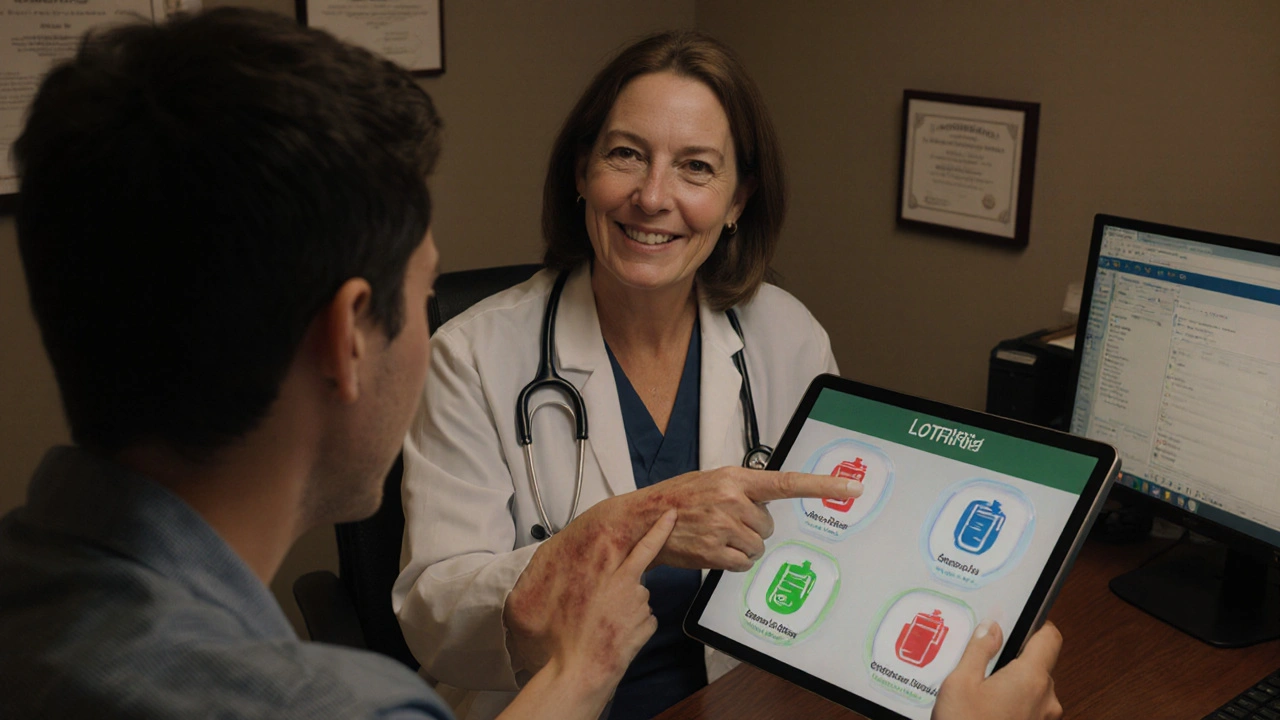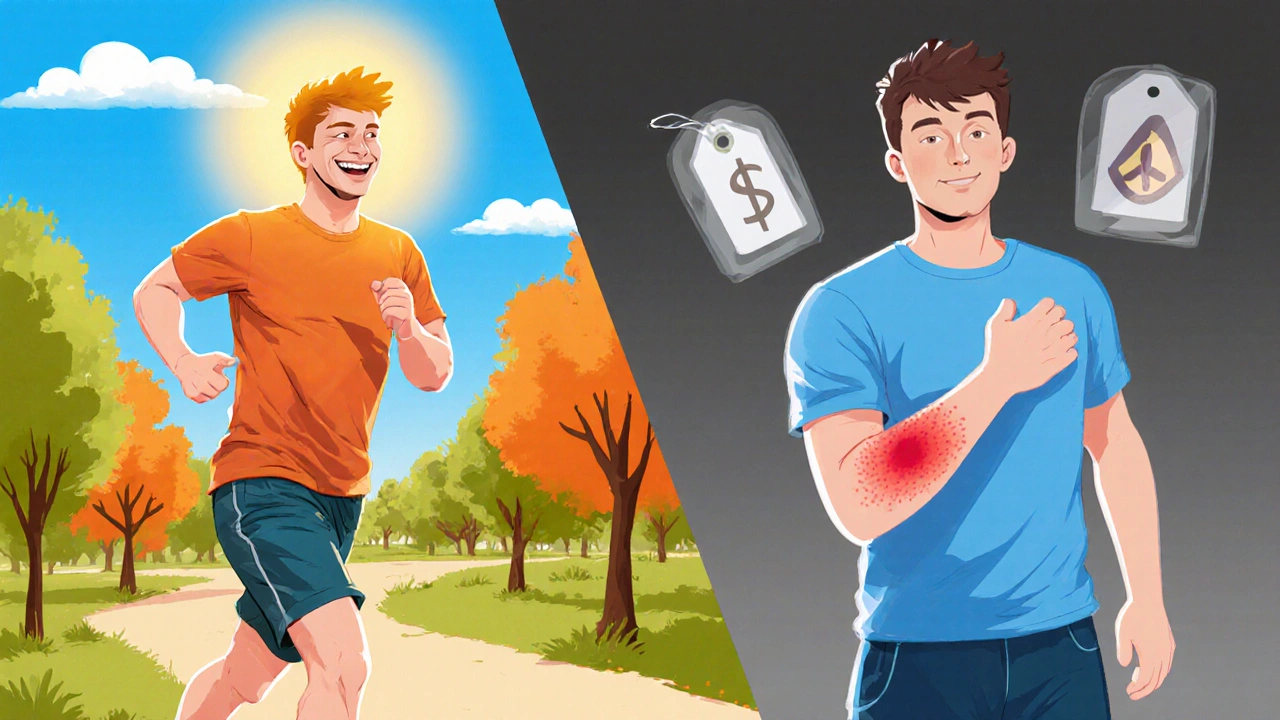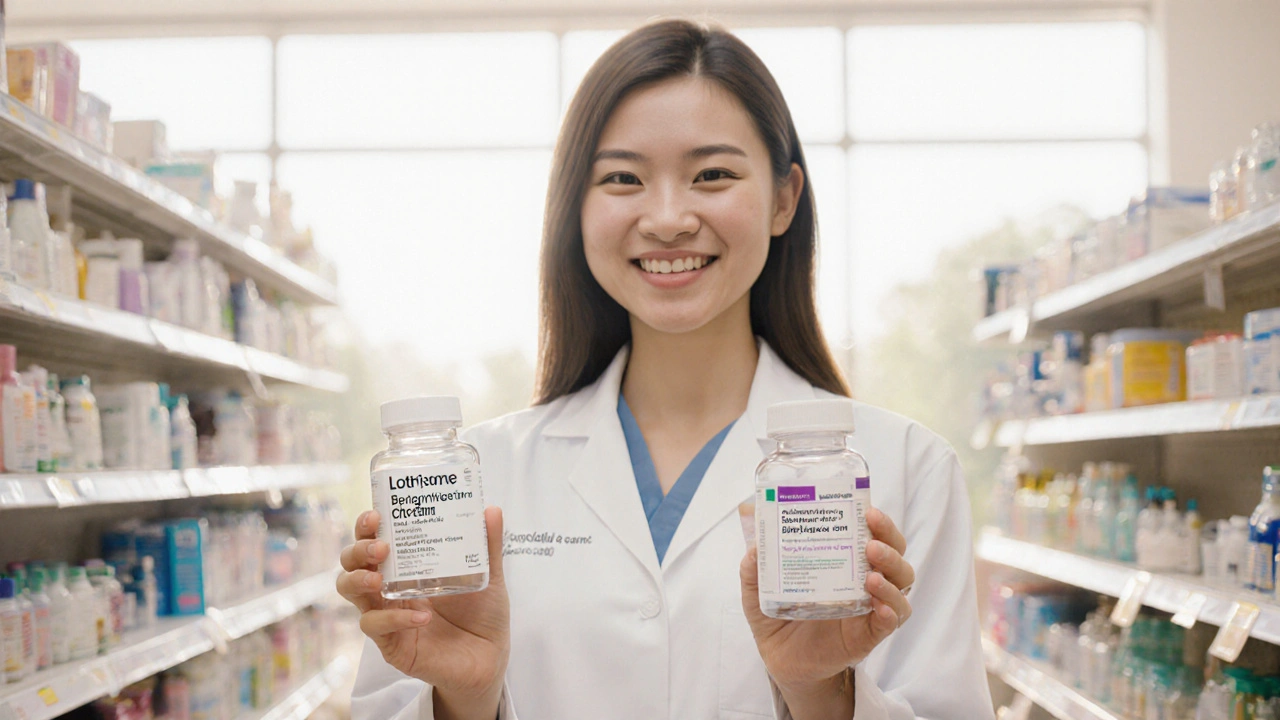Rash Treatment Selector
This tool helps you choose between Lotrisone and other antifungal/steroid treatments based on your rash symptoms.
When a rash stubbornly resurfaces, many reach for the familiar tube of Lotrisone is a combination cream that pairs the steroid betamethasone with the antifungal clotrimazole. It promises quick itch relief while tackling fungus, but is it truly the go‑to option? Below we line up Lotrisone against the most common alternatives so you can decide when to swipe it, when to skip it, and what else might work better.
What makes Lotrisone tick?
The magic in Lotrisone comes from two active ingredients:
- Betamethasone is a potent corticosteroid that calms inflammation, reduces redness, and eases swelling.
- Clotrimazole is an azole‑type antifungal that disrupts the cell membrane of dermatophytes, Candida, and some molds.
Because both work together, the cream can clear a fungal infection and tamp down the itch in one step. FDA‑approved for athletes’ foot, jock itch, ringworm, and yeast infections of the skin, it’s a handy standby for anyone dealing with mixed‑type rashes.
How do the major alternatives stack up?
Not every skin problem needs a steroid‑antifungal combo. Below are the most frequently recommended stand‑alone options.
- Nystatin is a polyene antifungal that binds to ergosterol, creating pores in fungal cell walls. It’s the first‑line choice for Candida‑only infections, especially in moist areas like the groin.
- Miconazole is another azole that blocks the synthesis of ergosterol. It’s sold over‑the‑counter in creams, sprays, and powders for athlete’s foot and ringworm.
- Terbinafine belongs to the allylamine class and works by inhibiting squalene epoxidase, a key step in fungal sterol production. It’s praised for its short treatment courses (often 2 weeks) and high cure rates for dermatophytes.
- Hydrocortisone is a mild corticosteroid without an antifungal partner. It’s useful for purely inflammatory rashes like eczema or contact dermatitis, where no fungus is present.
- Ketoconazole is a broad‑spectrum azole often found in shampoo form for dandruff and seborrheic dermatitis, but a cream version exists for stubborn body rashes.
Each alternative shines in a specific niche. The key is matching the drug’s strengths to the infection’s profile.
Side‑by‑side comparison
| Product | Active(s) | Primary Use | Typical Duration | Strengths | Drawbacks |
|---|---|---|---|---|---|
| Lotrisone | Betamethasone 0.1% + Clotrimazole 1% | Mixed fungal‑inflammatory rashes | 1-2 weeks | Fast itch relief + fungal kill | Potential steroid side‑effects; not for pure fungal infections |
| Nystatin | Nystatin 100,000IU/g | Candida‑only infections | 2-4 weeks | Safe for infants; no steroid | Ineffective against dermatophytes; slower relief |
| Miconazole | Miconazole 2% | Athlete’s foot, jock itch, ringworm | 2-4 weeks | OTC, widely available | May cause burning; no anti‑inflammatory action |
| Terbinafine | Terbinafine 1% | Dermatophyte infections (tinea) | 1-2 weeks | High cure rate, short course | Can be pricey; rare liver concerns with oral form |
| Hydrocortisone | Hydrocortisone 1% | Purely inflammatory rashes | Less than 2 weeks | Gentle, OTC | Useless for fungus; skin thinning risk if overused |
| Ketoconazole | Ketoconazole 2% | Dandruff, seborrheic dermatitis, some body rashes | 2-4 weeks | Broad‑spectrum | Potential hormonal side‑effects with systemic use; cream may be pricey |

When should you reach for Lotrisone?
Lotrisone shines in three scenarios:
- Mixed infection + inflammation. If a fungal rash is already inflamed, the steroid component cuts the itch while clotrimazole attacks the fungus.
- Quick symptom relief matters. Athletes, hikers, or anyone who can’t afford a week of constant scratching will love the rapid calm‑down effect.
- Prescription‑only convenience. Some insurers require a single prescription rather than multiple OTC buys, making Lotrisone a cost‑effective bundle.
If your rash is purely fungal, you’ll waste the steroid and increase the chance of skin thinning. In those cases, a single‑agent antifungal like terbinafine or miconazole does the job without the extra risk.
Safety profile and common side effects
Both ingredients are generally safe when used as directed, but they’re not free of warnings.
- Betamethasone. Prolonged use can lead to skin atrophy, stretch marks, or telangiectasia. Never apply to broken skin or use on the face for more than a week without a doctor’s OK.
- Clotrimazole. Rarely causes local irritation or a mild burning sensation. Systemic absorption is negligible, so drug interactions are uncommon.
Patients with diabetes, immune suppression, or a history of steroid‑responsive skin conditions should check with a clinician before starting a steroid‑containing cream.
Cost, insurance, and where to buy
Lotrisone is a prescription‑only product in the United States. Average retail price for a 30g tube hovers around $12‑$15, but many pharmacy benefit plans cover at least 80% of the cost. Over‑the‑counter alternatives like miconazole or terbinafine cream are typically $5‑$10 for the same amount.
If you have a high‑deductible health plan, compare the out‑of‑pocket price of the prescription against the total cost of buying two separate OTC products (e.g., hydrocortisone + clotrimazole). In many cases, the OTC combo ends up cheaper, but the convenience of a single prescription can outweigh the price difference.
Bottom line - pick the right tool for the job
Lotrisone isn’t a universal cure‑all, but it’s a solid choice when you need both anti‑inflammatory power and antifungal action in one squeeze. If your rash is purely fungal, opt for a dedicated antifungal like terbinafine for a faster cure and less steroid exposure. For purely inflammatory issues, reach for a mild steroid such as hydrocortisone. And when the infection is stubbornly mixed, Lotrisone can save you a trip to the pharmacy for two separate tubes.

Frequently Asked Questions
Can I use Lotrisone on my face?
Facial skin is thin, so the steroid component can cause irritation or even thinning if used longer than a few days. It’s better to stick with a mild hydrocortisone or a non‑steroid antifungal for facial rashes, unless a dermatologist specifically recommends Lotrisone.
How long should I apply Lotrisone?
Most doctors advise a 1‑ to 2‑week course, applying a thin layer twice daily. If the rash clears before the end of treatment, you can stop, but don’t discontinue early if inflammation is still present.
Is Lotrisone safe for children?
Pediatric use is allowed, but the dose may be reduced and the treatment period shortened. Always follow a pediatrician’s guidance, especially for infants under two years.
What if I’m allergic to clotrimazole?
Allergy to clotrimazole is rare but possible. Symptoms include redness, swelling, or hives right after application. Switch to a different class, such as terbinafine or nystatin, and discuss alternatives with your clinician.
Can I use Lotrisone and a moisturizer together?
Yes-apply the Lotrisone first, let it dry for a few minutes, then follow with a fragrance‑free moisturizer. This helps prevent the skin from becoming overly dry, which can worsen itching.


Emer Kirk
September 29, 2025 AT 17:53Ugh another cream hype lotrisone sounded promising but now i’m stuck with itchy skin again i feel like my skin is betraying me
Roberta Saettone
September 30, 2025 AT 16:06Sure, if you enjoy mixing steroids with antifungals like a cocktail, Lotrisone can be handy. For pure fungal infections, skip the betamethasone – a single‑agent such as terbinafine or miconazole does the job faster and cheaper. Remember, steroids on the face are a “great idea” only if you like thinning skin, so stick to hydrocortisone for facial rashes.
Sue Berrymore
October 1, 2025 AT 14:20Alright, folks, you’ve got this! When the rash is both itchy and fungal, a combo like Lotrisone can knock out the inflammation and the fungus in one swoop. If it’s just fungus, grab a terbinafine cream and give it a solid two‑week course – you’ll see results quick. Keep the skin moisturized after treatment and watch that irritation disappear like a bad habit.
Jeffrey Lee
October 2, 2025 AT 12:33Lotrisone is just another US pharma gimmick – why pay extra for a steroid when a plain antifungal works fine. Most docs just push the combo to boost their Rx numbers. If you want to save cash, stick with miconazole or clotrimazole, they’re just as effective.
Ian Parkin
October 3, 2025 AT 10:46Esteemed readers, it is my sincere belief that one should evaluate the nature of the dermatological affliction prior to selecting a therapeutic agent. Should the eruption exhibit both inflammatory and fungal characteristics, the concomitant action of betamethasone and clotrimazole within Lotrisone may indeed be appropriate. Conversely, for isolated fungal infections, monotherapy with agents such as terbinafine is advisable, thereby obviating unnecessary steroid exposure.
Glenn Gould
October 4, 2025 AT 09:00Yo just slap some terbinafine on that fungus and it’ll clear fast!
Poonam Sharma
October 5, 2025 AT 07:13Listen, you’re ignoring the fact that steroid‑antifungal combos are a strategic defense against resistant dermatophytes, a concept our medical community has championed for decades. The pharmacodynamics of betamethasone synergize with clotrimazole, enhancing epithelial penetration and curbing cytokine‑mediated inflammation. Dismissing this as “just a gimmick” betrays the scientific rigor our nation’s dermatology leaders uphold.
Meigan Chiu
October 6, 2025 AT 05:26Contrary to popular belief, Lotrisone isn’t the universal panacea some claim. While it excels in mixed infections, its steroid component can exacerbate fungal resistance when used indiscriminately. Hence, I advise reserving it for cases where inflammation is pronounced and a monotherapy would be insufficient.
Quiana Huff
October 7, 2025 AT 03:40Hey team! 🚀 If you’re battling a stubborn tinea with itch‑driven inflammation, think of Lotrisone as a dual‑action nano‑emulsion that targets ergosterol synthesis while dampening NF‑κB pathways. But for pure candida, a nystatin slurry or oral fluconazole will out‑perform the combo. Keep the regimen consistent and watch the mycelial load drop dramatically!
Richard Walker
October 8, 2025 AT 01:53I’ve seen both sides of the debate – some patients swear by the quick relief Lotrisone provides, while others prefer to avoid steroids altogether. In my experience, a brief course (no more than 10‑14 days) works well for mixed rashes without causing notable skin thinning. As always, monitor the area and stop if irritation persists.
Julien Martin
October 9, 2025 AT 00:06While navigating dermatologic options, it’s helpful to remember the distinction between fungistatic and fungicidal agents. Lotrisone offers a fungicidal component via clotrimazole, supplemented by the anti‑inflammatory action of betamethasone. For patients wary of steroids, a step‑down approach – starting with the combo then switching to a pure antifungal – can be effective.
Jason Oeltjen
October 9, 2025 AT 22:20People need to stop treating their skin like a chemistry experiment. If you’ve got a simple fungal foot infection, just buy an OTC miconazole and stop blowing up the pharmacy bill with unnecessary steroids.
Mark Vondrasek
October 10, 2025 AT 20:33Alright, let me pull back the curtain on this whole “Lotrisone miracle” narrative that the pharmaceutical industry pushes like a cult anthem. First, the steroid component is a classic example of over‑medication, designed to keep you coming back for more prescriptions because the skin can’t heal on its own once you mess with its natural cortisol rhythm. Second, the antifungal clotrimazole is deliberately under‑dosed in the combo, meaning you get just enough to keep the fungus at bay while the steroid does the heavy lifting of making you feel better, all the while the fungus mutates in the shadows. Third, the marketing teams love to brag about “dual action” as if it’s some sort of super‑hero, but no reputable study has shown that this mix is superior to a sequential regimen of a mild steroid followed by a proper antifungal. Fourth, if you think the side‑effects are negligible, think again – skin atrophy, telangiectasia, and systemic absorption risks are real, especially when users apply the cream to large surface areas or the face. Fifth, the hidden agenda is plain: push a prescription‑only product that insurers will co‑pay, making patients think they’re getting a “value pack” while the pharmacy margins swell. Sixth, the alternative over‑the‑counter agents like terbinafine or miconazole are perfectly adequate for pure fungal infections and cost a fraction of the price. Seventh, every time you hear a doctor say “Lotrisone is a good first‑line for mixed rashes,” remember they’re often incentivized by pharma reps. Eighth, the safety data sheets are peppered with warnings about prolonged use, yet the instructions whisper “use for up to two weeks,” a loophole that encourages abuse. Ninth, the real problem is the lack of patient education – most folks can’t differentiate between inflammation caused by fungi versus an allergic reaction, so they blindly trust the combo. Tenth, if you’re prone to diabetes or have a compromised immune system, adding a potent steroid to a fungal infection can tip the balance toward systemic complications. Eleventh, the only reason I’ve seen Lotrisone work is when the inflammation is severe enough that a steroid is genuinely needed, and even then I’d prefer a separate, lower‑potency steroid to avoid unnecessary clotrimazole exposure. Twelfth, the cultural push for “quick fix” creams reflects a deeper societal impatience with natural healing processes. Thirteenth, I advise anyone reading this to consult a dermatologist, demand a breakdown of the active ingredients, and consider a stepwise approach rather than a one‑size‑fits‑all combo. Finally, remember that your skin is a living organ – treat it with respect, not as a blank canvas for every new drug that hits the market.
Joshua Agabu
October 11, 2025 AT 18:46Lotrisone can work well for mixed rashes, but if you only have a fungal infection, a plain antifungal is enough and avoids steroid side effects.
Lolita Rosa
October 12, 2025 AT 17:00Honestly, I’m tired of the endless debate – it’s obvious that our country’s doctors know best, and they’ll prescribe Lotrisone when they see any redness, even if it’s just a minor itch.
Matthew Platts
October 13, 2025 AT 15:13Just remember, a short course of Lotrisone isn’t scary – if you stop when the itching fades, you’ll be fine.
Matthew Bates
October 14, 2025 AT 13:26In conclusion, the selection of an appropriate dermatologic agent should be predicated upon a precise diagnosis; prescribing Lotrisone without confirming a mixed fungal‑inflammatory etiology constitutes a deviation from evidence‑based practice.